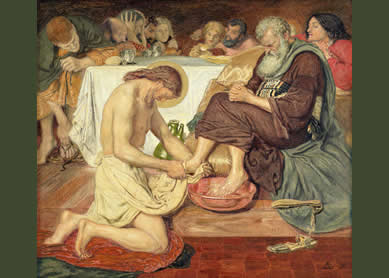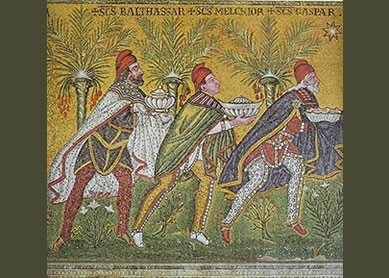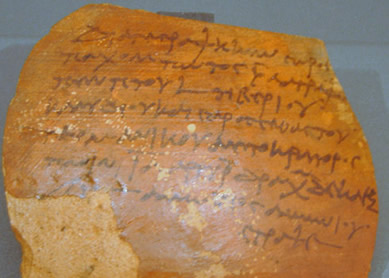The most familiar artistic depictions of the birth of Christ include the full cast of characters from the New Testament infancy narratives: the father Joseph and the mother Mary, a swaddled baby lying in a manger, shepherds, and angels. Yet the oldest known representations (from around 320 C.E.) focus primarily on the arrival of the magi. These paintings depict the Virgin Mary, seated on a high-backed chair, holding the baby Jesus on her lap and receiving the gift-bearing visitors (figure 1).
The magi’s popularity may reflect the antiquity and importance of the Feast of Epiphany. Or it may be the work of interpreters who saw the magi’s visit as a key moment—when Christ was revealed to the Gentiles and they in turn recognized his dual human and divine natures. The magi’s three gifts represent Jesus’ presumed roles as king (gold), God and high priest (incense), and sacrificial human victim (myrrh).
Although the adoration of the magi continued to be a favorite subject, the art of the early Middle Ages typically depicts the Virgin reclining on a large cushion following her delivery of her child. Compared to the older iconography, these scenes were more elaborate and included the Gospel of Luke’s shepherds, Joseph, and the Gospel of Matthew’s star. They also incorporate details drawn from the apocryphal gospels (the Protevangelium of James and the Infancy Gospel of Pseudo-Matthew)—midwife, ox, and ass—and set Christ’s nativity in a cave rather than a stable (figure 2). Additionally, Joseph is often shown as separated from the mother and child, frequently as a type of comic character—an elderly man, grouchily warming soup or darning socks. Another frequent addition, the bathing of the child, has no known textual source and may have been included to emphasize the infant’s humanity or possibly to foreshadow his baptism.
This type of nativity composition changed dramatically in the late fourteenth century, following the mystical vision of Saint Bridget of Sweden (1303-1373). According to Bridget’s vision, while Joseph waited outside the stable, Mary knelt, turned her back to the manger, and in the midst of a rapturous prayer suddenly produced her child in a burst of light. The naked, radiant baby needed no bathing (his body was thus free from impurities). Recognizing her infant’s divine nature, Mary turned and immediately knelt to worship him. Thus, images of Mary and Joseph kneeling, hands clasped and heads bowed before their divine child, became the standard presentation of the Holy Family in the West (figure 3). Most of these compositions show the child naked in order to emphasize his humanity but also as a glowing source of light, in order to express his divine nature.
Because this story was known only in the West, the tableau of mother and father praying to their baby rarely appears in Eastern Christian art. Thus, Orthodox Christian iconography usually reflects the earlier, traditional composition, showing Jesus’ birth in a cave and the Virgin Mary reclining on a cushion. Behind her, the swaddled baby lies in a small rectangular crib (perhaps an allusion to his later entombment—wrapped in a shroud and also in a cave), while both ox and ass hover protectively over the child. Such Nativity icons consistently include one or two women bathing the child, shepherds, angels, and magi. Joseph usually appears off to one side and often turned away from the mother and child, his posture and expression suggesting confusion or doubt (figure 4). In contrast with the Western images, which emphasize the child’s miraculous birth and the uncompromised joy of his attendants, Eastern icons allow haunting allusions to his mother’s vulnerability, his human father’s anxiety, and his own future death and burial.
Bibliography
- Metropolitan Museum of Art. The Christmas Story. New York: Abrams, 2009.
- Loverance, Rowena. Christian Art. Cambridge, Mass.: Harvard University Press, 2007.
- Hornik, Heidi J., and Mikeal C. Parsons. Illuminating Luke: The Infancy Narrative in Italian Renaissance Painting. Harrisburg, Pa.: Trinity Press, 2003.
- MacGregor, Neil, and Erika Langmuir. Seeing Salvation: Images of Christ in Art New Haven: Yale University Press, 2000.
- Jensen, Robin M. Understanding Early Christian Art. New York: Routledge, 2000.





